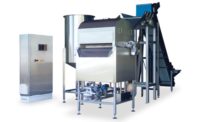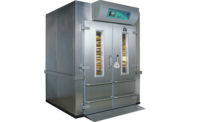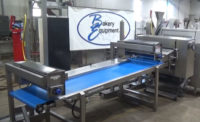Bakeries and snack makers in the market for ovens, proofers, fryers, and dryers have a healthy list of features and benefits in mind. These include capabilities for customization and flexibility, reliability and consistency, temperature control, faster processing times and continuous production, and automation that operators can control and monitor remotely.
Automation and reliability are consistently top-of-mind for Bakon USA, Torrance, CA, says Luc Imberechts, owner and president. “Those are constants,” he says.
Flexibility also factors into this equation. “When you go through a crisis like COVID-19, people realize the need for more flexibility,” says Imberechts. For example, this could include developing a good understanding of what bakers can do with cold technology, such as preparing croissant dough in advance, with consistent proof quality, and then baking within an hour, he says.
Customers of Alkar-RapidPak, Lodi, WI, want to significantly improve standard process times without a loss in quality—such as still getting browning on both sides of a roll, for example, and hitting the desired internal temperature, says Steve King, product line manager. “They also want to be able to be more productive and nimble, in case of an order change, when it comes to their schedule,” he says.
Customization and flexibility lead the list for customers of MP Equipment, Gainesville, GA, says Tom Van Doorn, director of sales. The snack food sector has boomed during the COVID-19 shutdowns, he adds, although packages are getting smaller—and they’re more likely to include protein than carbohydrates.
The Fred D. Pfening Co., Columbus, OH hears requests for customization, says Brian Doan, project engineer. “A lot of people are just asking for custom boxes to fit their own needs,” he says. “Every bakery is a little different.”
Continuous production and automation are top concerns for customers of MIWE America, Hillsborough Township, NJ, says Mathias Klotz, president. “I see strong demand on the batch production side for deck ovens with loaders,” he says. “Hipsters, people who started in a backyard business five years ago, grow very quickly when they get investors.”
Customers of G&F Systems, Roosevelt, NY, are most interested in maintaining product orientation, quality, and consistency through spiral proofing systems, says Anthony Salsone, associate.
Radio Frequency Co., Millis, MA, has seen consistent requests for greater throughput from existing lines, as well as increased interest since FSMA took effect for pasteurization applications to meet kill-step temperature requirements, says Lisa Mitchell, marketing manager.
Customers of Koenig Bakery Systems, Ashland, VA, are always looking for user-friendly control panels, says Richard Breeswine, president and CEO. “This is why we developed the new oven control, which basically works like a mobile device,” he says.
TNA North America, Coppell, TX, has seen more interest in the ability to make reduced-fat products, says Teri Johnson, divisional sales manager, North America—especially with regard to potato chips or kettle chips.
Efficient ovens
New and improved ovens rolled out in recent months include the new Turbo Chef industrial oven from Alkar-RapidPak, which cooks with either microwave, steam, or convection, and handles products spanning jerky and cheese sticks to breaded mushrooms. “It’s very versatile,” King says. “We’ve been able to greatly reduce processing time.” Cheese sticks go from frozen to cooked in less than three minutes.
MIWE has introduced a new rack oven called the Orbit that aims to meet quality without bells and whistles, Klotz says. “It’s straightforward, reliable, quick to set up, very efficient, and easy to operate,” he says. “The touchscreen can switch between English and Spanish. It’s a complete new generation, not an upgrade, and not based on anything prior to that.” It’s used for rolls, buns, and pastries, he adds.
Koenig has released new controls on the Roto Passat SE ovens, which the company says emphasizes user-friendliness with an intuitive set of functions and a wide range of parameters to achieve a fine-tuned result. Thawing frozen products is now possible with a new defrost function, and the “SE” stands for Save Energy execution, providing greater energy efficiency. In addition, the new model improves upon hygienic design with an easily removable, toolless ramp, Breeswine says.
AMF Den Boer, part of AMF Bakery Systems, Ashland, VA, has introduced new patent-pending technology that uses green energy. The Multibake VITA Tunnel Oven leverages hydrogen-fueled burners, which nearly eliminate carbon dioxide emissions, rather than using only steam and water in the baking process. The modular oven works well for artisanal and soft breads, baguettes, pizzas, and pastries, among other products.
Banner-Day, Lake Forest, IL, is focused on providing improved ovens that are just like new, for customers who would rather modernize the oven they have by upgrading the combustion system, updating the burners and controls, or adding automation, sometimes coupled with a mechanical rebuild, says Mike Day, president. “We do that in a much shorter period of time than if you were to purchase a new oven,” he says. “It’s much more efficient, less down time, and probably two-thirds of the money.”
Improved proofers
New and improved proofers include the retarder/proofer produced by Koma and distributed exclusively in the U.S. and Canada by Bakon USA. This three-in-one product combines freezer, refrigerator, and proofer, and helps to control temperature, humidity, and air circulation and flow. “Those things are important and have a direct impact on the quality of the product,” Imberechts says. “There are plenty of interesting technical advances that allow us to remotely control and monitor those units.” Operators can contact the KControl touchscreen from a cell phone, and troubleshooting is available around the clock from a Netherlands-based monitoring team.
Koenig has released the new Combiline plus EC, along with the Industry Rex Compact AW dough divider and rounders. The line provides an increased capacity of 33 strokes per minute at six rows, resulting in nearly 12,000 pieces per hour, as well as a proofer with 320 swings for a proofing time of about 10 minutes. The Easy Clean Design includes sloping surfaces at a 45-degree angle, as well as easily removable transfer belts and cover plates, says Breeswine.
The Pfening Co. has released the new Model 300 proof box, an improvement on the old Model 110 design with better panels and trim configuration to make it less thermally isolated, leading to less condensation, as well as a droplet eliminator between the humidification tube and the radiator, protecting the latter and extending its life, Doan says. “The new air handling units come with a heavy-gauge, all-welded sump pan in the bottom, so there’s less leakage and better longevity,” he says.
The G&G Spiral Proofing system combines the benefits of spiral conveying with a high-quality conditioning system, providing consistent size, texture, and appearance, Salsone says. The proofing system consists of an air-handling system that integrates several components designed to maintain humidity, air movement, and temperature, usually installed outside the proofer enclosure. “G&F engineers its Spiral Proofing system with bakery products as the design base,” he says. “Our Spiral Proofing systems are fitted with variable-frequency drives on all supply fans to allow airflow adjustment, ensuring product quality and a reduction in energy waste.”
Flexible fryers and dryers
In the fryer space, tna Solutions has gone into production with a machine called the Immerso Cook that handles multiple products that require substantially different fry times, ranging from pork rinds to wheat pellets, Johnson says. “Most companies don’t use the same fryer for those and need more space in the plant,” she says. Using one flexible fryer saves space on the footprint—and saves capital costs. “We’ve tried to make the Immerso Cook pretty flexible with regard to the applications it can do, and with regard to each customer’s needs.”
The Dynamic Action Fryer from Heat and Control Inc., Hayward, CA, uses a patented rocking paddle conveyor system to move product efficiently and consistently, says Don Giles, director of sales, processing systems. The fryer handles a wide range of products without the need for washing, including potato chips and sticks, banana and plantain chips, and cassava and malanga/taro chips. “The elimination of slice washing reduces freshwater usage, eliminates wastewater effluent, increased finished product yield, and reduces fuel usage,” he says.
MP Equipment provides lines like the new Duo Max used to create fried, breaded products such as friend green beans, cheese curds, or chicken nuggets, Van Doorn says. “That gives either a smooth, finished, fried appearance, or what we call a ‘homestyle,’ or handed-breaded, appearance to products,” he says. “The MP Duo Max dual-mode breader can give either finish in higher maximum capacities.”
On the dryer side, Heat and Control has rolled out the Rotary Dryer/Roaster, which provides a continuous, gentle, and sanitary system for snacks like nuts, seeds, pellets, and protein-based bites, says Giles. The dryer/roaster combines high-volume convective and focused airflow with rotary motion to ensure uniform heating, as well as a drum design that facilitates first-in-first-out product flow.







